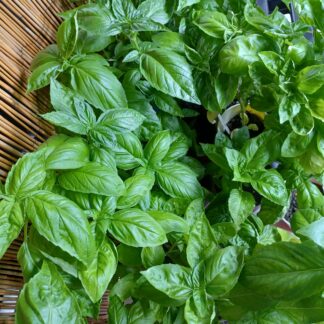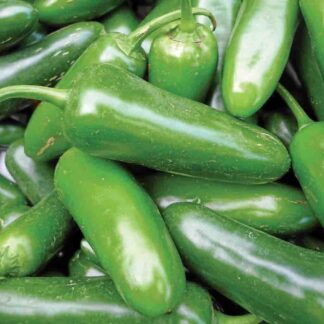Description
| Days To Maturity 50 – 55 |
Mature Spread 12 inches |
| Mature Height 12 – 18 inches |
Light Requirement Full Sun |
How To Plant
Planting in the Garden:
- Select a location in full sun where water drains quickly after a rainfall.
- Prepare the bed by turning the soil under to a depth of 8 inches. Level with a rake to remove clumps of grass and stones.
- Dig a hole for each plant large enough to amply accommodate the root ball.
- Carefully remove the plant from its pot and gently loosen the root ball, if tight, with your hands to encourage good root development.
- Place the top of the root ball even with the level of the surrounding soil. Fill with soil to the top of the root ball. Press soil down firmly with your hand leaving a slight depression around the plant to hold water.
- Water thoroughly, so that a puddle forms in the saucer you have created. This settles the plants in, drives out air pockets and results in good root-to-soil contact.
- Use the plant tag as a location marker.
- Do not allow plants to dry out, but never let the soil stay wet.
How To Care
- Water thoroughly, so that a puddle forms in the saucer you have created. This settles the plants in, drives out air pockets and results in good root-to-soil contact.
- Do not allow plants to dry out, but never let the soil stay wet.
Tips
- Harvest cilantro leaves before the flower stem has developed.
- Harvest coriander seeds once they start turning from green to gray-brown.
- The leaves may be dried or frozen. Use them fresh in Asian and Mexican dishes; they taste is better than the smell.
- The ripe seeds are an important ingredient in curry. They are also used as a pickling spice or sugar-coated and eaten as candy.
Common Pests and Diseases
Common Pests:
- Aphids: Greenish, red, black or peach colored sucking insects can spread disease as they feed on the undersides of leaves. They leave a sticky residue on foliage that attracts ants. TBK Nursery Recommends: Introduce or attract natural predators into your garden such as lady beetles and wasps who feed on aphids. You can also wash them off with a strong spray, or use an insecticidal soap.
- Deer: Plants may be eaten to the ground. TBK Nursery Recommends: Try a deer repellent or physical barrier for young plants.
- Slugs: These pests leave large holes in the foliage or eat leaves entirely. They leave a slime trail, feed at night and are mostly a problem in damp weather. TBK Nursery Recommends: Hand pick, at night if possible. You can try attracting the slugs to traps either using cornmeal or beer. For a beer trap, dig a hole in the ground and place a large cup or bowl into the hole; use something that has steep sides so that the slugs can’t crawl back out when they’re finished. Fill the bowl about ¾ of the way full with beer, and let it sit overnight. In the morning, the bowl should be full of drowned slugs that can be dumped out for the birds to eat. For a cornmeal trap, put a tablespoon or two of cornmeal in a jar and put it on its side near the plants. Slugs are attracted to the scent but they cannot digest it and it will kill them. You can also try placing a barrier around your plants of diatomaceous earth or even coffee grounds. They cannot crawl over these.
- Whitefly: These are small white flying insects that often rise up in a cloud when plants are disturbed or brushed against. TBK Nursery Recommends: They are difficult to control without chemicals. Try hot pepper wax or insecticidal soap.
Common Diseases:
- Bacterial Leaf Spot: First signs are small translucent spots with a broad yellowish edge that slowly enlarge and become angular or irregularly circular with a reddish center. It thrives in cooler temperatures. The disease may also affect and disfigure flower heads. TBK Nursery Recommends: Remove infected plants. Rotate crops with plants in a different family. Avoid overhead watering. Do not work around plants when they are wet.
- Botrytis Blight: Causes the older leaves and the center of the plant to rot. It can start with a yellowish brown irregular spots on the leaves or water soaked spots on the stems. The fungus turns a fuzzy gray and emits a cloud of spores when touched. TBK Nursery Recommends: Remove infected plants and plant debris to avoid the spread of the disease and make sure plants have good air circulation. Keep organic mulches away from the plants as spores can live in the organic matter. Use pea gravel as mulches they will help decrease humidity around the plants.
- Powdery Mildew: This fungus disease occurs on the top of the leaves in humid weather conditions. The leaves appear to have a whitish or greyish surface and may curl. TBK Nursery Recommends: Avoid powdery mildew by providing good air circulation for the plants by good spacing and pruning.
- Root Knot Nematodes: Microscopic worm-like pests that cause swellings (galls) to form on roots. Plants may wilt or appear stunted. This is a serious problem in many Southern states. TBK Nursery Recommends: Do not plant into infested soil. Grow resistant varieties. Try planting ‘Nema-Gone’ marigolds around your plants.







